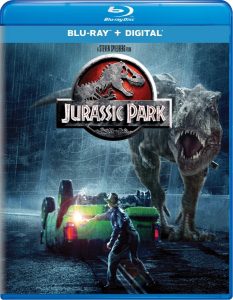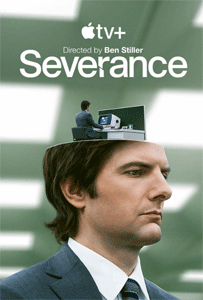Like a long-form “Twilight Zone,” “Severance” Season 1 (Apple TV Plus) mixes mind-bending “What ifs” about brain surgery, pitch-black humor about cubicle life, and characters who grow from drones into people we desperately root for. The nine episodes are laced with fresh angles into questions of self-determination, self-worth and self-betrayal.
Helly yeah!
Created by newcomer Dan Erickson (who pens three hours) and grandly but efficiently directed by Ben Stiller and Aoife McArdle, “Severance” leaves questions for future seasons but is emotionally fulfilling. I wasn’t hooked right away by the story (that takes until episode six, “Hide and Seek”), but Helly R. (Britt Lower) kept me coming back in the early going.
She’s not the main character; that’s her boss in the four-cubicle Lumon workspace, Mark S. (Adam Scott, also an office drone on “Parks and Recreation”). Pretty in a natural way, the lithe redhead initially drew my sympathy. In episode one (“Good News About Hell”), Helly wakes up alone in a conference room with amnesia and is told by a disembodied voice that she has accepted a job with this unknown company.
“Severance” Season 1 (2022)
9 episodes, Apple TV Plus
Showrunner: Dan Erickson
Stars: Adam Scott, Britt Lower, John Turturro
“Severance” is too slow and grim in the first five episodes, which call to mind 1970s sci-fi like “THX-1138.” (SPOILERS FOLLOW.)
I watched each episode after a work shift. My job includes moving things from queue to queue in a program — not exactly what I got into journalism for, but such is the nature of assembly line efficiency.
The jobs of Mark, Helly, Dylan G. (Zack Cherry) and Irving B. (John Turturro) involve looking at a screen of numbers, finding the “scary” clusters and dumping them in the trash. It’s like they’re trapped in an experiment that asks “How long are people willing to work a job where they not only don’t see the end point, but don’t even know what the point is?”
(Also making me think “experiment,” their computers are 1980s vintage, yet viewers’ excursions into the smartphone-laden outer world suggest “Severance” is set in present day.)
What’s worse, they never get to go home. Mark, Helly, Dylan and Irv are “innies” — when one work shift ends, the next begins. When Helly realizes this, her depression and sense of being trapped is palpable; this is a nightmare for every clock-puncher. Even if you like your job, the 16 hours in between are essential for mental health.
Work-life imbalance
It wasn’t “our” Helly who made the decision to get the “severance” brain operation. It was her “outie” — the person who benefits from getting all the free time and none of the work time.

Episode nine (“The We We Are”) features a double-meaning line from a side character to Outie Helly: “It’s nice to meet you, finally.” Viewers meet Helly’s innie in the first scene and her outie in the finale, after we’ve gotten to know Mark’s outie and some basics about Dylan’s and Irv’s. The season comes full circle even though questions remain, including about the very purpose of Lumon.
“Severance” isn’t budget-busting, but it gets mileage out of sets you don’t see in any old show. The four cubicles of Macro Data Refinement are in the center of a large green-carpeted room. Outside is a maze of white corridors. Although we eventually meet the people of Optics and Design, including the always entertaining Christopher Walken as Burt G. — a potential love interest for Irv — the underground Severance Floor remains vast and foreboding.
The dark comedy is spearheaded by Mr. Milchick (Tramell Tillman), a Good Cop/Bad Cop combo in the body of an overly attached HR man who reports to Miss Cobel (Patricia Arquette). He leads the “1984”-esque psychological torture sessions in the Break Room – the toughest scenes to watch – yet also leads Music & Dance Experiences and Waffle Parties.
When Milchick, Helly and Mark (Irv is too shy and Dylan too bitter to participate) dance in the office-turned-disco-club, we soak up the surrealism and let our minds drift. Work is no fun, but would dance parties make it better? Nah, probably only weirder.
Drone warfare
The dance sequence of episode seven (“Defiant Jazz”) also got me thinking about better ways Lumon might promote mental health in its workers. People would need a full life experience underground to stay sane for decades until their retirement (which, creepily, is death for the innie).
Lumon uses threats more than attaboys, and this is a statement on corporate life. So is Miss Cobel’s loyalty amid mistreatment from her mysterious bosses; even after being fired, she remains the enemy of our four heroes, trying to win back the approval of her puppet masters.
Another topic of debate: Would you get the severance procedure, knowing that your innie would work their whole life without time off? My friend said we couldn’t know how bad life would be for the innie, and – not knowing that — he would consider it. And besides, the innie is not him. I said definitely not; even on my worst day of self-loathing I wouldn’t do that to myself (or to “another person,” as your innie becomes – in a way).
And also: If your memories are severed, does that mean your emotions are, too? Not necessarily. Mark seems rather depressed on the outside, living in an underpopulated, snow-covered housing development. (I was thinking Wisconsin, subconsciously connecting Lumon with my company’s headquarters.)
There’s a danger with mind-benders like “Severance” (and this also points to why “Twilight Zone” and “Black Mirror” feature single-episode yarns): When it enters the phase where answers come fast and furious, the philosophical questions can get left in the dust.
In the thrilling final two episodes, though, Erickson’s show dodges that danger. The innie-outie dichotomy comes to the fore even as answers emerge and even as we root for Innie Mark and Innie Helly to overcome their own selves. When Season 2 rolls around, count me innie.


Yo!i completely agree. I havnt finished it yet. Like you mentioned, a slow dark grind right out of the gate. But I think stiller did well.